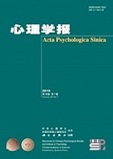|
|
The Effect of Central Executive Load on Adult’s Strategy Using in Computational Estimation
SI Ji-Wei;YANG Jia;JIA Guo-Jing;ZHOU Chao
2012, 44 (11):
1490-1500.
doi: 10.3724/SP.J.1041.2012.01490
Many models on strategy choosing in arithmetic cognition have been proposed, however, the role of central executive load in strategy utilization is still far from clear. A previous research with the Choice Reaction Time task (CRT) found that working memory load didn’t affect children's strategy utilization (Imbo & Vandierendonck, 2007). In another study, Logie, Gilhooly and Wynn (1994) reported that different sub-tasks affected mental arithmetic. More recent studies also revealed that the inhibition and shifting capacities mediated age-related differences in strategy selection (Lemaire & Lecacheur, 2011; Hodzik & Lemaire, 2011). Dual-task paradigm is commonly utilized in exploring working memory load in arithmetic performance, and the choice/no-choice is a standard method to obtain unbiased data about strategy utilization. In this study, we employed the dual-task paradigm and choice/no-choice method to investigate the influence of central executive load upon individual strategy utilization during arithmetic processing. 128 college students were tested by the dual-task paradigm and choice/no-choice method. They were asked to finish a two-digit addition computational estimate and a secondary task at the same time. The experimental design was as following: 5 (consistent –high load, consistent –low load, inconsistent –high load, inconsistent –low load, no load) × 4 (free-choice condition, best-strategy choice condition, no-choice/rounding-up condition, no-choice/rounding-down condition). The main task was to finish 30 two-digit addition questions, and the secondary task was Han and Kim’s (2004) design with some modifications. Results showed that: 1) Central executive load did not affect adult’s strategy distribution. But comparing with free-choice condition, adults used less rounding-down strategy under the best -strategy choice condition (F(4,123) = 0.58, p> 0.05); 2) Central executive load affected how participants selected (F(4,123) = 11.10, p < 0.05) and executed (F(4,123) = 23.36, p <0.05) arithmetic strategies. Under consistent situation, the impact of central executive load on reaction time of strategy execution increased with the strength of central executive load, while central executive load on the correct rate of strategy execution had little effect; Under inconsistent situation, low-central executive load almost did not affect the reaction time and correct rate of strategy execution; Central executive load strength played an important role on reaction time of strategy choice, interference became significant only when central executive load of the secondary task was high; 3) Adult's adaptivity of strategy choice was affected by the strength of central executive load, F(4,123) = 2.46, p < 0.05. They showed a better adaptivity of strategy choice under no central executive load condition. The results of strategy utilization in this study confirm the SCADS model. Adults can select strategies according to external requirements, but their adaptivity was still vulnerable. Secondary task type significantly affected strategy utilization of adult. The larger similarity between the sub-task and the main task leaded to larger interference to main task.
Related Articles |
Metrics
|




